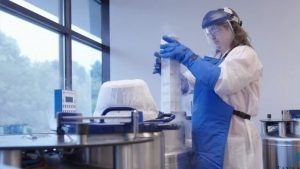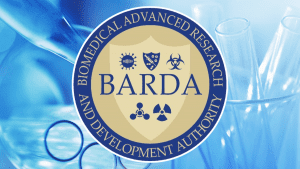Cell Therapy to Replace All Modern Medicine?
In order: Phil Vanek, PhD (GE Healthcare); Claudia Zylberberg, PhD (Akron Biotechnology); Joshua Hare, MD (Longeveron); Doug Doerfler (Maxcyte) participate in the “Realizing the Potential of Stem Cell Therapies” panel at the TEDCO Entrepeneur Expo
November 9, 2018
The TEDCO Stem Cell Symposium included several speakers and panels covering the most important topics that researchers and business are facing. These topics ranged from the promise of new Stem Cell therapy technologies to overcoming the current challenges in Translation, Scale Up, and Commercialization. During the Commercialization panel, moderator Phil Vanek (Cell and Gene Therapy Strategy at GE Healthcare) asked about the potential scale of Stem Cells. Panelist Joshua Hare (Longeveron), was quick to reply, “The scale is enormous. I personally believe cell therapy will replace all modern medicine.”
While fellow panelists Claudia Zylberberg (Akron Biotech) and Doug Doerfler (Maxcyte, Inc.) did not necessarily join Hare in this conclusion, the panelists – each of whom has been involved in successful cell therapy-related businesses – were in consensus on a number of the hurdles that companies must be overcome to successfully get their products to patients.
One of the biggest hurdles is funding. Zylberberg noted that it is often difficult for traditional venture capitalists to adjust their thinking to the very long time frame involved in taking technology through translation and scale up, and on to commercialization. Hare added that he’d encountered “investors that love what you’re doing but it doesn’t fit their investment model.” The view was that venture funding would come more readily when there was more experience with the biotech commercialization process.
Another hurdle is the public perception of the technology. Patients are often reluctant to be the first adopters. As a result, it often takes time for the new process to be accepted. “As more people use it, the public opinion changes,” said Doerfler. The timeframe for this depended upon a number of factors, but Hare said, “in two to three years, Stem Cell products will be treating people with metabolic syndromes by IV.”
The hurdle of adoption by the medical community is also large. “Once the product is approved, there needs to be a re-education in the medical community.” Some of this re-education will necessarily include recognition of the more central role patients play in their care today. If there is a treatment they desire, they will request it from the physician. Zylberberg said, “We must not underestimate the power of the patient. They will push quite a bit themselves for what they’d like to see.”
The security of data collected in the research and development process is a definite concern. The data must be kept confidential while still being accessible by other teams wishing to use the data for their own studies. Once consent is given, there is still the issue of storing the data in a model that will fit the purposes of multiple groups. There is also the question of what to do if materials are screened and something unsought is found. Coincident with this question is the question of whether the screening is done once only, or will be done in the future, to look for new indicators – indicators that are unknown today.
Finally, there is the problem of getting the product to market once all of the other hurdles have been cleared. When asked what the most important part in success was, the panelists were in complete agreement. The team is most critical to success. The earliest members of the team may not be chosen for their specific knowledge, but rather for their vision and drive. What is essential is a group of people who are committed to the product and the company. And, Doerfler added, “Make sure you’ve got support at home from the partner, as well as a good group of friends and family to rely on.” The path to success is a process. You need a team that’s ready to go the distance.
The Maryland ecosystem has proven to be quite beneficial for those researchers and companies working to overcome these challenges, and move their innovations forward. With programs like the Biotechnology Investor Tax Credit, the Maryland Stem Cell Research Fund, and the MII Innovation Commercialization program, Maryland has shown their commitment to advancing the world leading cell therapy industry that is flourishing here.
The message from this panel echoed the message of the earlier panel (read more) moderated by Bryan Poltilove(Thermo Fisher Scientific). We may, as Matthias Alder (Autolus Therapeutics) said, find ourselves with Star Trek medicine forty years from now. Whether the work being done now leads to the future envisioned by Hare, or to the future Alder foresees, as Poltilove said, there’s reason to be “very excited about gene therapy and the promise of what it could do for patients and science.”





